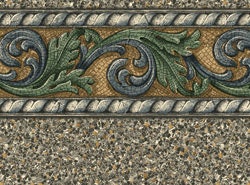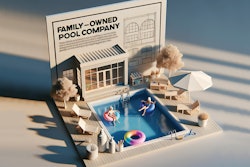
The industry has been moving in that direction, with most of the changes coming above the water line in the tile borders. New colors are also popping up on liner bottoms, though the industry remains a little more conservative in that area.
"We're finding that for the tile lines, people are looking for more of the earth tones, but the traditional blue and Caribbean-looking overall aesthetics of the water is still very much in demand," says J. Kevin Shea, senior vice president and chief marketing officer for Vyn-All Pool Products, a liner fabricator in Newmarket, N.H.
According to Shea, a big part of the reason his company has been reluctant to fully embrace browns and other non-traditional colors for liner bottoms is the discrepancy between what they look like inside and outside of the water.
"Most liners are sold from a display rack in a showroom or on a set of samples that are carried into the kitchen or the family room where the sales presentation is made," he explains. "Some patterns are very appealing at that level but don't look so great in the pool. There are others that don't have that same curbside appeal that look fantastic in the pool."
Shea cites a particular Vyn-All pattern that had a bottom composed mostly of black and white. Filled with water and colored by the sky, a rich blend of turquoise blues came out. "But as much as you told people that, they just couldn't get their heads around it," he says. "I don't know about other fabricators, but we tend to stay away from those a little bit, because with the amount of money that you invest in developing them and then engraving the cylinders, and the minimum yardage you have to buy, you want to be reasonably sure you're going to be able to sell it."
David Sones, a designer at Canadian General-Tower, a Cambridge, Ontario, manufacturer that sells vinyl to fabricators, acknowledges the spell that blue's cast over consumers, but says his company has found acceptance of non-blue bottoms increasing.
"We introduced a tan base film three seasons ago, and I've been pretty surprised at how well it's been received by the fabricators," he says. "They're willing to try something different.
"We did some research ourselves to see how it would look in the pool, and whether the water would still look blue. We do hear back now that our tan base has been around for a couple of seasons that the water still looks blue. I think the fabricators are starting to see that there are different color choices, and they're asking for different things and they're willing to be a little bit more experimental now."
Balancing Act
Manufacturers and fabricators are faced, then, with a dilemma. How do you set yourself apart from the crowd without taking risks on patterns that might not sell?
Pegasus Products, Branchburg, N.J., sells patterns with brown in the bottom, but, according to Roshan Patel, the company remains ambivalent about them.
"At least for our customers, brown has not piqued their interest," she says. "I've talked to other [fabricators] and they say, 'Oh, yeah, the brown sells really well for us.' But for us, I think we've found that the homeowner, no matter how much we want to get away from the blues, it doesn't matter; the homeowner always wants the blue."
Despite the slow sales of these brownish bottom patterns, Patel says Pegasus plans to stick with them, at least for the time being. That willingness to stick with the patterns has less to do with a hunch she's got about its potential and more to do with the way the vinyl market usually works.
"I think sometimes it takes about two years for a pattern to catch on and to become really popular," she says. "Why? I don't know. But it's usually good to have a pattern for at least two years because it may catch on in the second year."
One reason that riskier patterns find more buyers after the first year is that with a year on the market, many builders will have photos of installations for these patterns to show liner shoppers examples from the field.
T.J. Moreland is the business development manager for Merlin Industries in Hamilton, N.J. He encourages his installers to get out and take photos of installations, which Merlin then uses for a gallery on its Web site. Non-traditional patterns benefit most from this, he says, and that underscores the need to stick with a pattern for at least two years.
"When you look at a pattern like our Santiago, which is printed on tan, you don't know what it's going to look like in the pool," he says. "So until people are able to see it in the pool, they're not going to jump right on that bandwagon and say, 'I'm going to try that!'
"So sometimes it does take a couple of years."
Showroom Samples
While photo galleries can help convince vinyl-liner buyers that a brownish pattern won't make their pools look like water-treatment plants, there's no substitute for seeing a pattern in person. The best way to do that, according to manufacturers and fabricators, is to put one of the patterns into a display pool.
But dealers, like their suppliers, can't go too far out on a limb when selecting a pattern or patterns to display.
"It's tough to get a dealer to take a chance on a show pool," Moreland admits. "They fear they might lose a sale because people are turned off by the liner that's in the show pool. So a lot of times the dealers are going to stay conservative with the show pools, which is unfortunate.
"I mean, we all kind of tread lightly and hope for the best when we bring these things out, and it's understandable that they'd feel the same way with their show pools."
LOOP-LOC, Ltd. is an old and established brand in the pool cover market, but the company has only been making vinyl liners for about five years. Like all liner manufacturers and fabricators, the company tries to walk a fine line between innovation and making what it knows most customers will want, according to liner design manager Andy Tauvers.
"It is difficult to balance," he says, "because you can either go with too safe a pattern and not stand out, or you can go too dramatic and turn people off.
"Some will go for the more muted colors, others will want more vibrant colors. We try to mix those different colors and patterns that we're looking at on the different-colored films, just to try to give a little more of a balance and provide more choices to the customers."
Fred Boehmcke, a colleague of Tauvers at the Hauppauge, N.Y., fabricator, agrees, but points out the futility in trying to steer customers toward patterns that you think should sell rather than embracing ones that actually do sell.
"Of course, we've had some items that we brought on that didn't move, so we discontinued them and brought on fresh patterns," he says. "I don't think you're ever ahead of the trends; you just try to stay with the trends."







































